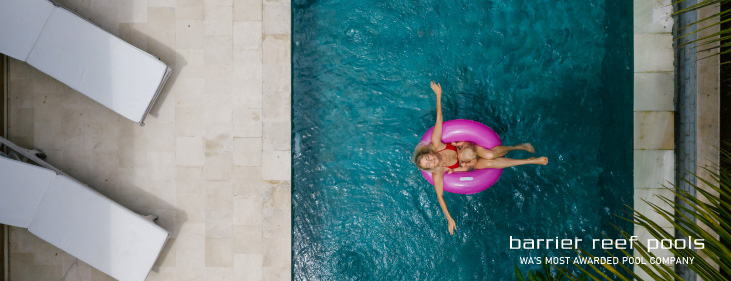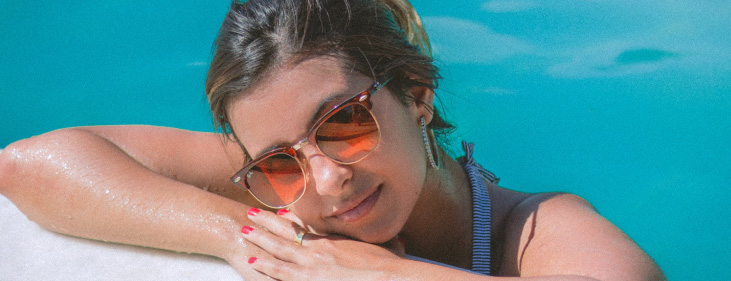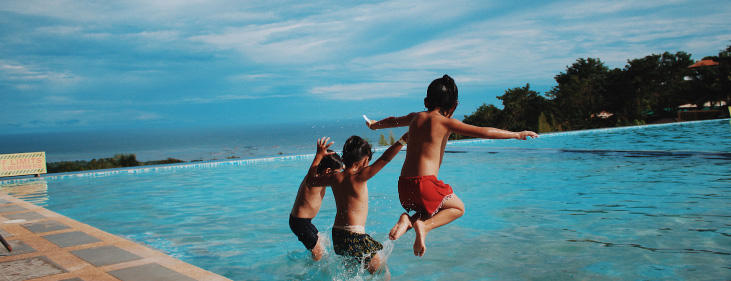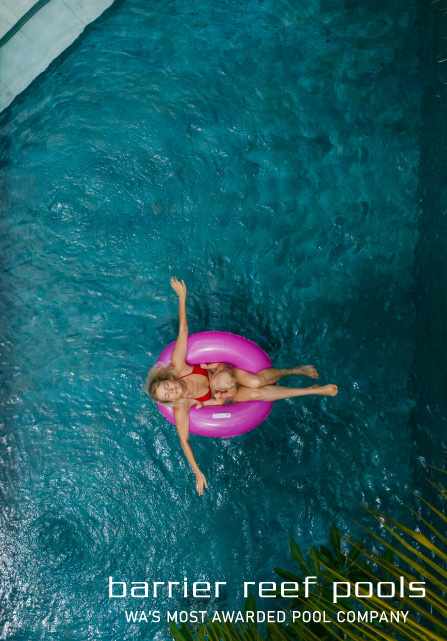Chlorine is a vital element in pool water. It helps to control harmful bacteria, algae and contaminants that can lead to water contamination and other health issues. But when you have a fibreglass swimming pool, it’s important that the chlorine levels remain within safe limits. This way, your family can enjoy their time at the pool safely.

If you use chlorinated water for cooling or heating purposes, then reducing chlorine costs might be one way for you to save money on energy costs. This will also ensure that you are maintaining the safety standards at home! Read on to learn exactly how you can do that.
Lower your swimming pool water temperature
Lowering the water temperature will reduce chlorination costs. It also has other benefits. Lowering the water to an average of 77 degrees Fahrenheit (25 Celsius) will reduce energy demand by up to 25% and maintenance costs by up to 20%. You can expect your pool to last longer and have fewer problems with algae growth when you lower its temperature.
Lowering your fibreglass swimming pool’s temperature is a great way to extend its season without affecting safety or accessibility.
Install an ozone system
If you want to lower your pool’s chlorine costs without compromising water safety, consider installing an ozone system. Ozone systems are more efficient than conventional chlorinators and more effective than most low-chlorine alternatives like bromine or iodine. They’re also less expensive than traditional chlorine dispensers and have been shown to reduce the amount of chemicals used in pools.
Unlike many other kinds of filtration systems, which require regular cleaning out or replacement over time due to buildup inside them, ozone filters do not require any maintenance whatsoever. They are self-cleaning! This means that you have to get it installed properly by professionals who know how best to integrate them into their facility’s overall design plans. This will ensure that they stay clean forever while providing years’ worth of service without ever needing attention again!

Add cyanuric acid to your swimming pool water exposed to sunlight
Cyanuric acid is a chemical that helps protect the chlorine in your pool water from sunlight. It works by absorbing excess ultraviolet light and preventing it from reaching the surface of your pool or spa. This can help save money on regular maintenance since you won’t need as many active ingredients for each dose of chlorination solution you use. However, this isn’t a substitute for adding an active ingredient like sodium hypochlorite tablets. Instead, it should be used regularly, at least once every two weeks because its effects will dissipate over time without constant use!
Install a salt chlorine generator
A salt chlorine generator is a more expensive option, but it can save you money. They’re typically about $500-$1,000 and can last for years if properly maintained. Salt generators use ionic compounds to break down the chlorine into smaller pieces that are easier for your body to absorb. Because they use salts instead of tablets or granules, they require less water than other types of generators. This means fewer trips back and forth from the pool room!
However, salt generators require regular maintenance. You have to check them regularly for corrosion or debris buildup around their heating element (which could cause damage).
Filter Pool Water
A pool filter can help lower chlorine costs by removing contaminants from your pool water. Filters are available in all shapes and sizes, from small pieces that sit on the ground to large above-ground stationary models. They come with several different features, such as waterfall or jet streams for added circulation.
Eliminate Organic Contaminants
Organic contaminants include algae and bacteria. These can be eliminated with a good filter system, but it’s important to choose the right type of filter for your needs. The best filters are sand filters, but they are expensive and difficult to maintain properly. The next best filter is a DE filter (disinfection chamber) that’s less expensive than sand filters. However, they cannot remove organics as well as other types of water treatment equipment such as ultraviolet lights or ozone generators.

Use Stabilised Chlorine
Stabilised chlorine is a type of chlorine that has been stabilised with a polymer. The polymer acts as a shield against the ultraviolet rays that cause it to break down and lose its effectiveness. This allows you to use less than regular or un-stabilised forms of chlorine. However, there are some drawbacks to using stabilised chlorine. For instance, it takes longer for your pool water to be treated with stabilised products than if you were using regular chlorine in the first place.
Test Pool Water Regularly
You should test pool water regularly to lower chlorine costs without compromising pool water safety.
- Before adding chlorine: Test your pool for pH, temperature and alkalinity. If the readings are below 7.2 and above 7.8 (or more acidic), add more acid to bring them back up to ideal levels—but don’t go overboard! Keep in mind that every time you add too much acid, it will not only cost more money but also make your swimming experience less enjoyable. This is because of irritation from the chemical reaction with the skin cells in your body (and any food or drinks).
- After adding chlorine: If there is still too much free-floating carbon dioxide in the solution then add an acid neutraliser agent. You can add sodium hydroxide (lye) or magnesium chloride tablets or granules at a rate of 1/4 teaspoon per 25 gallons of water. This will help draw out dissolved air pollutants, such as oxygen gas bubbles which can cause corrosion within pipes.
Conclusion
Improving your fibreglass swimming pool’s water quality is a great way to lower chlorine costs. While it may seem like an expensive investment, the benefits you receive will be worth every penny. Reducing your chlorine use and adding cyanuric acid can also help reduce other maintenance expenses like pool maintenance service fees and repairs. After all, no one wants to spend their hard-earned money on unnecessary pool upkeep!
Chlorine is a vital element in pool water. It helps to control harmful bacteria, algae and contaminants that can lead to water contamination and other health issues. But when you have a fibreglass swimming pool, it’s important that the chlorine levels remain within safe limits. This way, your family can enjoy their time at the pool safely.

If you use chlorinated water for cooling or heating purposes, then reducing chlorine costs might be one way for you to save money on energy costs. This will also ensure that you are maintaining the safety standards at home! Read on to learn exactly how you can do that.
Lower your swimming pool water temperature
Lowering the water temperature will reduce chlorination costs. It also has other benefits. Lowering the water to an average of 77 degrees Fahrenheit (25 Celsius) will reduce energy demand by up to 25% and maintenance costs by up to 20%. You can expect your pool to last longer and have fewer problems with algae growth when you lower its temperature.
Lowering your fibreglass swimming pool’s temperature is a great way to extend its season without affecting safety or accessibility.
Install an ozone system
If you want to lower your pool’s chlorine costs without compromising water safety, consider installing an ozone system. Ozone systems are more efficient than conventional chlorinators and more effective than most low-chlorine alternatives like bromine or iodine. They’re also less expensive than traditional chlorine dispensers and have been shown to reduce the amount of chemicals used in pools.
Unlike many other kinds of filtration systems, which require regular cleaning out or replacement over time due to buildup inside them, ozone filters do not require any maintenance whatsoever. They are self-cleaning! This means that you have to get it installed properly by professionals who know how best to integrate them into their facility’s overall design plans. This will ensure that they stay clean forever while providing years’ worth of service without ever needing attention again!

Add cyanuric acid to your swimming pool water exposed to sunlight
Cyanuric acid is a chemical that helps protect the chlorine in your pool water from sunlight. It works by absorbing excess ultraviolet light and preventing it from reaching the surface of your pool or spa. This can help save money on regular maintenance since you won’t need as many active ingredients for each dose of chlorination solution you use. However, this isn’t a substitute for adding an active ingredient like sodium hypochlorite tablets. Instead, it should be used regularly, at least once every two weeks because its effects will dissipate over time without constant use!
Install a salt chlorine generator
A salt chlorine generator is a more expensive option, but it can save you money. They’re typically about $500-$1,000 and can last for years if properly maintained. Salt generators use ionic compounds to break down the chlorine into smaller pieces that are easier for your body to absorb. Because they use salts instead of tablets or granules, they require less water than other types of generators. This means fewer trips back and forth from the pool room!
However, salt generators require regular maintenance. You have to check them regularly for corrosion or debris buildup around their heating element (which could cause damage).
Filter Pool Water
A pool filter can help lower chlorine costs by removing contaminants from your pool water. Filters are available in all shapes and sizes, from small pieces that sit on the ground to large above-ground stationary models. They come with several different features, such as waterfall or jet streams for added circulation.
Eliminate Organic Contaminants
Organic contaminants include algae and bacteria. These can be eliminated with a good filter system, but it’s important to choose the right type of filter for your needs. The best filters are sand filters, but they are expensive and difficult to maintain properly. The next best filter is a DE filter (disinfection chamber) that’s less expensive than sand filters. However, they cannot remove organics as well as other types of water treatment equipment such as ultraviolet lights or ozone generators.

Use Stabilised Chlorine
Stabilised chlorine is a type of chlorine that has been stabilised with a polymer. The polymer acts as a shield against the ultraviolet rays that cause it to break down and lose its effectiveness. This allows you to use less than regular or un-stabilised forms of chlorine. However, there are some drawbacks to using stabilised chlorine. For instance, it takes longer for your pool water to be treated with stabilised products than if you were using regular chlorine in the first place.
Test Pool Water Regularly
You should test pool water regularly to lower chlorine costs without compromising pool water safety.
- Before adding chlorine: Test your pool for pH, temperature and alkalinity. If the readings are below 7.2 and above 7.8 (or more acidic), add more acid to bring them back up to ideal levels—but don’t go overboard! Keep in mind that every time you add too much acid, it will not only cost more money but also make your swimming experience less enjoyable. This is because of irritation from the chemical reaction with the skin cells in your body (and any food or drinks).
- After adding chlorine: If there is still too much free-floating carbon dioxide in the solution then add an acid neutraliser agent. You can add sodium hydroxide (lye) or magnesium chloride tablets or granules at a rate of 1/4 teaspoon per 25 gallons of water. This will help draw out dissolved air pollutants, such as oxygen gas bubbles which can cause corrosion within pipes.
Conclusion
Improving your fibreglass swimming pool’s water quality is a great way to lower chlorine costs. While it may seem like an expensive investment, the benefits you receive will be worth every penny. Reducing your chlorine use and adding cyanuric acid can also help reduce other maintenance expenses like pool maintenance service fees and repairs. After all, no one wants to spend their hard-earned money on unnecessary pool upkeep!




